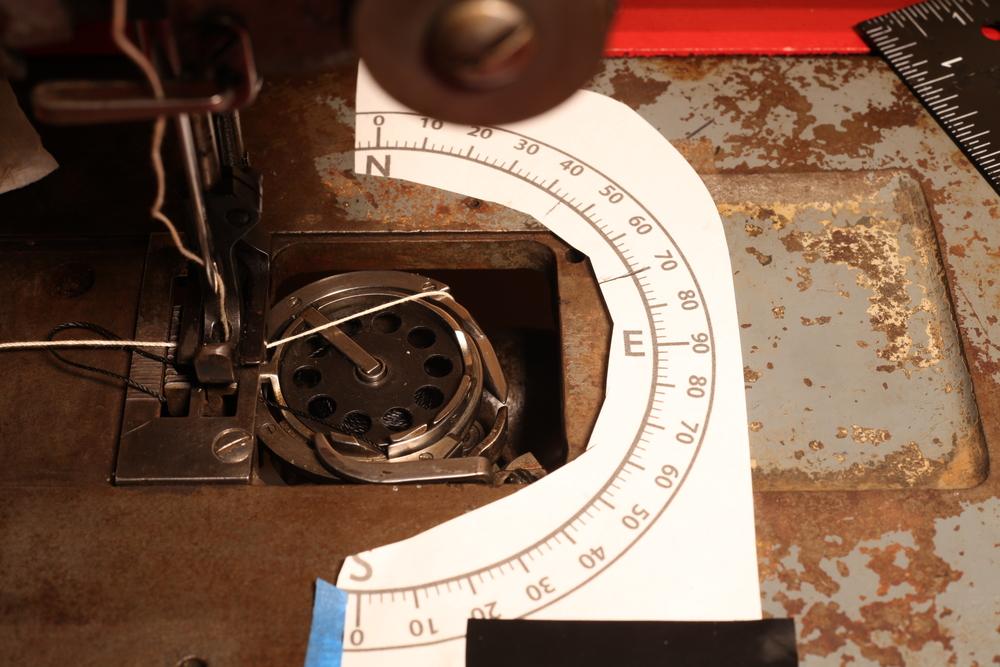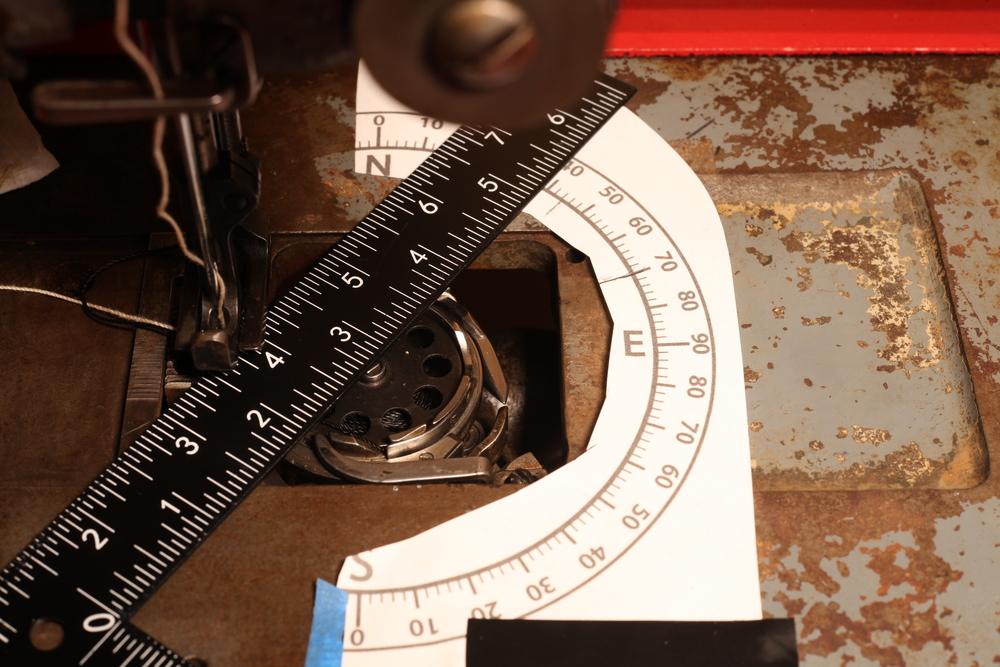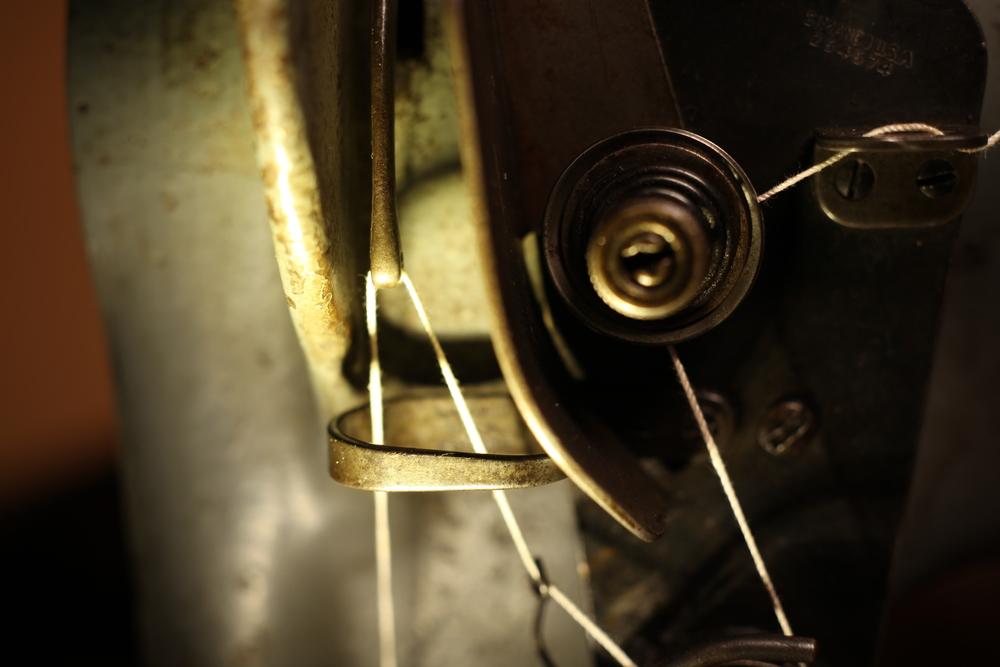Search the Community
Showing results for tags 'hook timing'.
-
Hook timing...what a drag! You remove some parts, insert a brand new needle, then get out the calipers and measure a tiny rise of the needle bar past bottom dead center. Afterwards, if the machine does not sew well, you repeat the process and hope for better results. That's why I'm going to start measuring hook timing another way---at least on my vertical hook-shaft machines. I'm going to start measuring degrees of hook rotation. Protractor I'll set up my axes like this: 0 degrees: when the hook shoulder is farthest from the user 90 degrees: when the hook shoulder reaches the apex of the hook's journey around the bobbin I'll print this protractor and tape it to the machine bed. Note the origin/center of the protractor is at the center of the hook/bobbin. Note in the photo above, the white top thread is stretched between the throat plate hole and what I've been calling the hook "shoulder". I'll rotate the hand wheel to where the take-up lever is at is lowest point. Then I'll take a measurement of the hook angle from the center of the hook to the hook shoulder. (I chose the hook shoulder because it is the part that actually drags the thread around the bobbin, and it is easy to see from the top.) If you click into this image you can see that the edge of the ruler/square crosses the center of the hook and crosses the hook shoulder where the bit of white thread is peeking out. Note this photo shows a 39 degree measurement. What This Measurement Style Provides: Easy to measure hook timing without removing anything but the bobbin cover plate Easy to visualize where the hook is in its cycle in relation to where the thread take-up lever is in its cycle Easy to make generalizations (I hope) about certain hook timing angles producing certain behavior/symptoms across lots of different machines The timing angle is the same regardless of what stitch length is selected The larger the timing angle, the more advanced the hook timing. (Note with the old/conventional measurement system, larger numbers mean the hook timing is less advanced.) The timing angle is the same regardless of how much the hook point is worn Background / Theory: The hook's job is to grab the top thread and drag it around the bobbin. As the hook shoulder rounds the apex of its path (goes around the right-most edge of the bobbin), that is the farthest that the thread gets dragged through the needle before the thread take-up lever pulls the thread back the other way. The hook shoulder going around the right-most edge of the bobbin must coincide roughly with the thread take-up lever being at its lowest point, otherwise the thread will be tight and the hand wheel hard to turn as the hook drags the thread round the bobbin. Some Data Points and Corresponding Behavior I was working on dialing in the timing on an old Singer, and to learn the machine better (and develop my skills) I was purposefully doing it without referring to a manual. Here are the timing angles on the left, and a description of the corresponding behavior on the right. 2° Top thread tight and grabby as it rounds bobbin 13° Top thread tight and grabby as it rounds bobbin 20° Top thread tight and grabby as it rounds bobbin 44° Most of rounding bobbin is easy...but snags just a bit on the hump by the bobbin tension spring 46° Easy to round bobbin. Good clearance between nearly-formed loop and hook 51° Easy to round bobbin. Minimal clearance between nearly-formed loop and hook 70° Very easy to round bobbin. Negative clearance between nearly-formed loop and hook. (The hook stabs into the nearly-formed loop and jams the machine.) In this round of measurements, the 46 degree setting was my favorite. (I did not get more measurements between 30 degrees and 44 degrees because I was having trouble getting the worm gear slid into position.) Making Generalizations By trying out various timing angles, I was able to observe certain behaviors and put them on my mental map of what causes those behaviors. (And can hopefully fix some of the tendencies from the "70°" row that I've been having on a different machine!) Hope this is useful to someone wanting to understand not just how to set hook timing by the book, but how to react to certain (mis)behaviours, and possibly how to design a sewing machine 😀
-
I'm working on my 111W153 and reading lots of resources. Somewhere on this forum someone mentioned that another adjustment went hand in hand with hook timing (can't remember what, offhand). I'm wondering if there's an order of operations or list of other adjustments to make when looking at hook timing on these 111 machines? My timing seems to be right on but I'm not entirely convinced something else doesn't need to be tweaked. Thanks
-
I recently bought a Pfaff 545 to sew veg tanned leather journals, wallets, bags, and more. Had problems with hook timing because of old screws buggered slots on shaft. I cut deeper slots into screws allowing me to tighten down properly. Hook timing solved I think. Now I am trying to use size 138 thread top and in bobbin sews fine going forward but if I try to lock stitch creates jam on bobbin side of leather. My question is to big thread in bobbin or timing off by small adjustment. I really would like to use 138 on both sides for finished look. I would also like to use 207 size thread need to know if that is possible. I have learned more about sewing machines in the last month than I thought possible but still a newbie. I need to sew with no issues, so far I spend more time tinkering with machine than sewing. I would appreciate all the help you can offer. Thanks Jeff
- 26 replies
-
- thread size
- sewing machine
-
(and 1 more)
Tagged with:
-
Hello you all ! I am owner of a Pfaff 491 industrial sewing machine with the folllowing problem: when stiching, the loop thats is build by the upper thread and is normally caught by the hook sometimes isnt staying in a 90 degree angle to the hook but turns backwards so that the hook misses the loop. This results in missed stich. https://youtu.be/aKOQkTJQ338 I made a video to show the problem. In case you have any ideas I would be very happy for suggestions. greetings ! ssl2013
- 1 reply
-
- pfaff 491
- sewingmachine
-
(and 2 more)
Tagged with:






